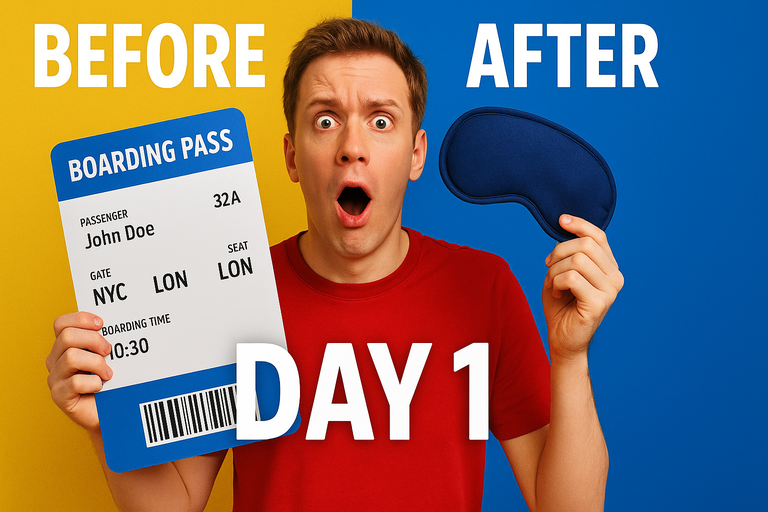
Ever spent your first day in Paris at a café—head drooping, eyelids fighting gravity—wishing you could swap your croissant for a pillow? If you’ve survived a transatlantic flight, you know the unique joy of jet lag: being wide awake at 2 a.m., then zombified by 9 a.m., with your body clock hopelessly tangled in time zones. Why does jet lag feel like getting tossed in a cosmic washing machine? And, more importantly, is there a way to emerge from your next red-eye flight feeling refreshed instead of wrecked?
After reading Wired’s game-changing article, How to Beat Jet Lag, I dove down the rabbit hole of sleep science, chatted with globetrotters, and—yes—tested the weirdest anti-snore gadgets on the market. Here’s what I learned (and the one shockingly simple trick that could change your mornings forever).
Why Jet Lag Isn’t Just “Sleepiness on Steroids”
Let’s get nerdy for a sec. Jet lag isn’t just being tired after a long flight. It’s a full-on war between your internal clock (a.k.a. your circadian rhythm) and your new time zone. When you fly from, say, LA to Tokyo, your body still thinks it’s yesterday, and nothing—neither sushi nor endless coffee—can convince it otherwise.
But what if I told you that light exposure, meal timing, and a certain snoring solution could tip the odds in your favor?
1. Hack Your Brain with Plane Lighting
The Wired article drops this bombshell: airlines are now using LED lighting to trick your brain into resetting faster. Blue light in the morning, amber in the evening—it's science, not sorcery! This can help your body start “acting local” before you even land, but what do you do once you’re off the plane?
2. Eat Like a Local—Even If It’s Pizza for Breakfast
Meal timing matters. Experts recommend syncing your meals to the new local hours as soon as possible. So, if breakfast in Paris means a croissant at noon in your old time zone, go for it. Your stomach—eventually—will thank you.
3. Don’t Nap (Yet!)—Move Instead
Here’s the truth: napping after you land is the express train to Jet Lag City. Instead, take a brisk walk in natural daylight. Physical activity helps reset your body clock, raises your energy, and lets you collect more Instagram-worthy selfies. Win-win-win.
4. Master the Pre-Bed Routine—No Matter Where “Bed” Is
This is where many people flop—literally. After a flight, your brain is already confused. Make things easy with a consistent routine: calming music, a book (not your phone), a quick meditation, or some deep stretching. It’s like giving your body a gentle “bedtime nudge.”
5. The Secret Weapon: Optimizing Your Actual Sleep
You’ve timed your meals, you’ve walked off the plane-funk—now for the “insider” tip. Good sleep isn’t just about hours; it’s about quality. And here’s where many frequent flyers spill their most unlikely secret: keeping their airway open.
When you’re sleeping in a stuffy hotel room, after a dry flight, your body works overtime to get oxygen. This increases your risk of snoring—even if you’ve never snored before. Why does this matter? Because snoring leads to micro-awakenings, which means fragmented, useless sleep. You wake up groggy, cranky, and still stuck in last week’s time zone.
Enter the modern anti-snoring device. The Snorple Anti-Snoring Mouthpiece isn’t your grandpa’s dental guard. It’s a customizable, latex-free superhero that keeps your airway open, even when your body would rather be in a different hemisphere. Unlike old-school boil-and-bite gadgets, Snorple preps in a microwave (fancy, right?) and lets you adjust just how much your jaw advances. Seasoned road warriors have found that waking up without snoring can be a game-changer for feeling energized—even after a 13-hour flight.
6. Stay Hydrated, But Not “Bathroom-Every-Hour” Hydrated
Long flights dry you out, but chugging water to the point of hourly sprints down the airplane aisle isn’t ideal either. Gentle hydration is best: think sips of water, herbal teas, and maybe one glass of juice. Save the triple espressos for after you’ve landed.
7. Accept That Mornings May Be Weird—But You Can Still Glow
Let’s be honest: that first sunrise after a long-haul will always feel a bit… off. But with these hacks—especially optimizing your actual sleep quality—your “weird” morning can also be your best one. Who says only locals get to sparkle?
The Grand Finale: Wake Up Energized, Wherever You Are
To sum it up:
- Use light exposure to your advantage on the plane AND off.
- Eat like a local ASAP.
- Move more, nap less.
- Build a bedtime routine that travels with you.
- Never underestimate the power of good, uninterrupted sleep (and the right gear).
Next time you (and your circadian rhythm) are plotting a journey around the globe, remember: you don’t have to sacrifice your mornings to jet lag. With a few smart strategies—and a little help from modern sleep tech like the Snorple Anti-Snoring Mouthpiece—you can step off the plane ready for anything.
So: what’s your weirdest jet lag story, and what’s the one thing that’s helped you bounce back the fastest? Let’s trade secrets in the comments!